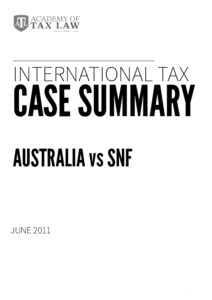Australia vs SNF: CASE SUMMARY
Home » Case Library »
Australia vs SNF: CASE SUMMARY
Case Information
- Court: Full Federal Court of Australia
- Case No: 2011 ATC 20-265
- Applicant: Commissioner of Taxation
- Defendant: SNF (Australia) Pty Ltd
- Judgment Date: 1 June 2011
- Download the FULL JUDGMENT
Judgment Summary
The case Commissioner of Taxation v. SNF (Australia) Pty Ltd concerned a dispute over the application of the arm’s length principle in the context of transfer pricing regulations under Australia’s Income Tax Assessment Act 1936 (ITAA 1936). SNF, a subsidiary of the French-based multinational SNF Group, had imported chemicals—primarily polyacrylamides—from related foreign suppliers in France, the United States, and China. The Commissioner challenged the pricing of these imports, arguing that SNF Australia had paid its related suppliers more than an independent buyer would under comparable circumstances. Consequently, the Commissioner assessed additional income tax on SNF, claiming that the prices paid exceeded the arm’s length amounts required under Section 136AD(3) of the ITAA 1936.
The core of the dispute focused on whether the prices paid by SNF Australia were indeed at arm’s length, as defined by the law. SNF argued that it had paid comparable prices, often less than those paid by independent third-party buyers. The Commissioner, however, contended that SNF’s methodology was flawed and instead applied the Transactional Net Margin Method (TNMM), which the Commissioner argued better reflected arm’s length considerations.
The Federal Court supported SNF’s use of the Comparable Uncontrolled Price (CUP) method over the Commissioner’s preferred TNMM. It found that SNF had valid comparables, showing it generally paid lower prices than independent parties for similar goods. Consequently, the Commissioner’s adjustments were set aside, affirming that SNF’s transactions were within acceptable transfer pricing boundaries. The ruling underscored the importance of carefully selected comparables in transfer pricing and the court’s reliance on specific transaction-based evidence over broader profit-based measures when sufficient comparables exist.

